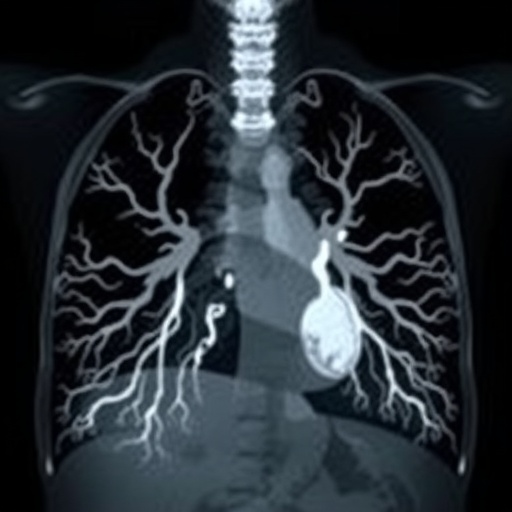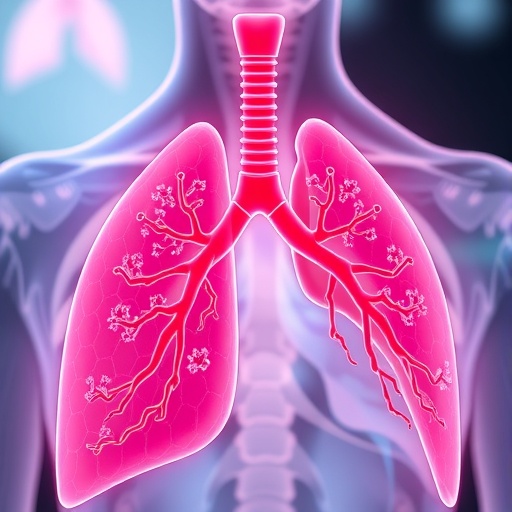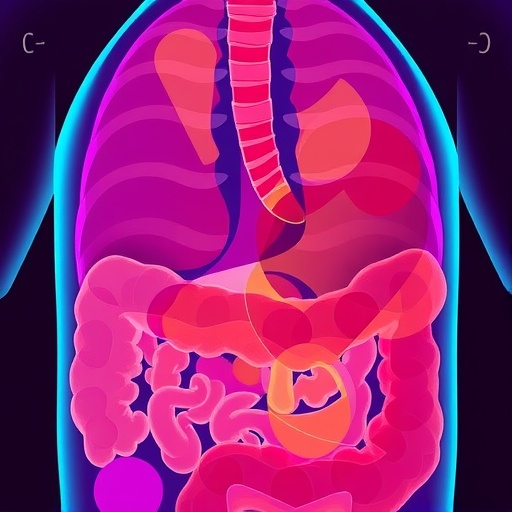A groundbreaking study published recently in the esteemed journal Radiology reveals a potent and previously underappreciated link between emphysema detected via baseline low-dose computed tomography (LDCT) and long-term mortality outcomes. Conducted on a vast cohort exceeding 9,000 asymptomatic individuals undergoing lung cancer screening, the research illuminates that emphysema, even when initially unnoticed, significantly predicts death not only from chronic obstructive pulmonary disease (COPD) but also cardiovascular diseases within a remarkable 25-year follow-up window. These insights herald a new frontier in preventive medicine, underscoring the critical importance of comprehensive image analysis during routine lung cancer screening.
Emphysema is a chronic and progressive respiratory disorder characterized by irreversible damage to alveolar air sacs, which reduces lung elasticity and impairs gas exchange. The primary etiological factors include prolonged inhalation of harmful irritants, notably tobacco smoke and environmental pollutants. Traditionally considered primarily a respiratory malady, emphysema’s systemic consequences have remained less clearly defined, particularly in asymptomatic populations. This latest investigation clarifies that emphysema’s impact extends far beyond pulmonary function, influencing overall mortality risk substantially.
The longitudinal study, spearheaded by Dr. Claudia I. Henschke, a renowned radiologist and professor at the Icahn School of Medicine at Mount Sinai, harnessed data from the International Early Lung Cancer Action Program (I-ELCAP). Between 2000 and 2008, over 9,000 adults aged 40 to 85, all with significant smoking histories, underwent baseline LDCT scans. Participants were meticulously scored by an experienced chest radiologist on a four-point visual emphysema scale ranging from zero (no emphysema) to three (severe emphysema). This visual scoring alongside extensive follow-up data until death or the end of 2024 enabled a robust association analysis between emphysema severity and mortality outcomes.
Curiously, the study revealed that nearly 30% of all participants exhibited some degree of emphysema at baseline, with 21.1% categorized as mild, 5.7% moderate, and 2.4% severe. Strikingly, approximately 80% of these individuals had no previous diagnosis of the condition, signifying a vast reservoir of undetected disease within screened populations. This unawareness poses critical clinical challenges as emphysema’s presence portends a significantly elevated risk not only for pulmonary decline but also systemic complications impacting cardiovascular health.
Among the deceased cohort, cardiovascular disease emerged as the predominant cause of death, claiming 12.7% of participants, closely followed by COPD-related mortality at 3.3%. Emphysema severity correlated with escalating risk ratios for all-cause mortality and cause-specific death. Mild emphysema doubled the risk of death from COPD, while severe cases demonstrated a staggering 12-fold increase in COPD mortality risk. Contrastingly, emphysema’s influence on cardiovascular mortality was less clear-cut, suggesting complex pathophysiological pathways between pulmonary parenchymal damage and vascular disease.
These findings critically challenge the prevailing convention that lung cancer screening should focus narrowly on nodule detection. Dr. Henschke emphasizes that a holistic approach to LDCT interpretation—one that evaluates the entirety of the pulmonary landscape—is essential. The presence of emphysema should no longer be relegated to incidental notation but recognized as a potentially life-altering biomarker predictive of long-term health outcomes. This paradigm shift necessitates enhanced radiologist training and the integration of emphysema scoring into standard screening protocols.
The underlying mechanisms linking emphysema and cardiovascular mortality remain an active area of investigation. Hypotheses propose that chronic hypoxia, systemic inflammation, and oxidative stress stemming from alveolar destruction may accelerate atherosclerosis and cardiac dysfunction. Furthermore, emphysema’s impact on pulmonary vasculature may directly exacerbate right heart strain. This multifactorial interplay underscores the interconnectedness of respiratory and cardiovascular systems, warranting collaborative efforts between pulmonologists, cardiologists, and radiologists.
Equally compelling is the demographic distribution of emphysema within the cohort. Older participants and those with greater cumulative smoking exposure, as measured by pack-years, were more likely to manifest emphysematous changes. Notably, slightly higher emphysema prevalence among males (30.1%) compared to females (28.2%) suggests potential sex-based biological differences or exposure patterns warranting further scrutiny. These epidemiological insights pave the way for targeted risk stratification and precision medicine interventions.
The clinical implications of incorporating emphysema visual grading into lung cancer screening are far-reaching. Early identification enables proactive management strategies to mitigate disease progression and potentially reduce mortality. Interventions could include smoking cessation reinforcement, pharmacologic therapies, exercise rehabilitation, and vigilant cardiovascular risk monitoring. Moreover, this approach aligns with the burgeoning field of predictive health, leveraging imaging biomarkers to forecast disease trajectories decades in advance.
The existing guidelines from the United States Preventive Services Task Force advocate annual LDCT screening primarily for adults aged 50-80 with significant smoking histories. However, findings from Dr. Henschke’s team advocate for reconsidering these criteria to encompass non-smokers and broader populations susceptible to emphysema and related mortality. Approximately one-third of lung cancer deaths occur in individuals without smoking histories, highlighting the need for expanded screening paradigms embracing a more diverse risk profile.
Looking ahead, the success of this research underscores the necessity for integrated, multidisciplinary care frameworks. Pulmonologists, cardiologists, and radiologists must synergize to interpret LDCT findings comprehensively and translate them into individualized patient care plans. The future of lung health rests not solely on nodule surveillance but on holistic evaluation and management of all detectable pathology within the thoracic cavity.
In summary, this seminal work catalyzes a transformative vision for lung cancer screening programs, embedding emphysema detection as a critical prognostic marker. It amplifies an urgent call for radiology professionals to extend their diagnostic acumen beyond conventional boundaries. By harnessing the full spectrum of imaging data, clinicians can meaningfully intervene to curb the deadly sequelae of emphysema and improve both respiratory and cardiovascular outcomes—a leap forward in the quest for long-term health and longevity.
Subject of Research: People
Article Title: Emphysema at Baseline Low-Dose CT Lung Cancer Screening Predicts Death from Chronic Obstructive Pulmonary Disease and Cardiovascular Disease Up to 25 Years Later
News Publication Date: 9-Sep-2025
Web References:
https://pubs.rsna.org/journal/radiology
https://www.rsna.org/
http://www.radiologyinfo.org
References:
“Emphysema at Baseline Low-Dose CT Lung Cancer Screening Predicts Death from Chronic Obstructive Pulmonary Disease and Cardiovascular Disease Up to 25 Years Later,” Radiology, RSNA International Early Lung Cancer Action Program Investigators.
Image Credits: Radiological Society of North America (RSNA)
Keywords: Respiratory disorders, Lung cancer, Cardiovascular disorders, Life expectancy
Tags: chronic obstructive pulmonary disease predictorsDr. Claudia I. Henschke researchemphysema detection on CT scansenvironmental factors affecting lung healthimplications of imaging in healthcarelink between emphysema and cardiovascular diseaseslong-term health outcomes of emphysemalow-dose computed tomography lung screeningmortality risk in asymptomatic adultspreventive medicine and lung cancer screeningsystemic effects of respiratory disordersunderstanding lung disease progression





